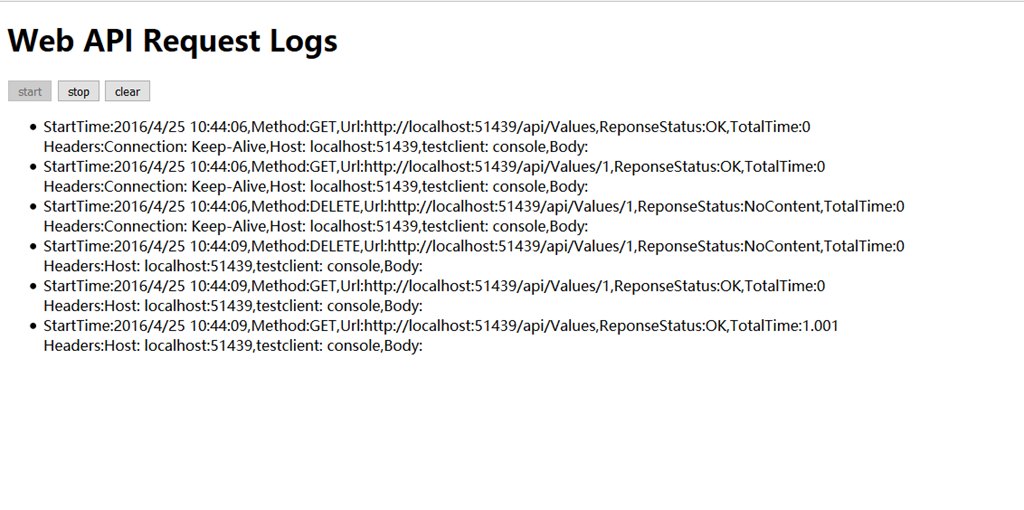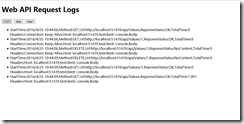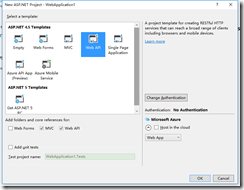用SignalR实现实时查看WebAPI请求日志
实现的原理比较直接,定义一个MessageHandler记录WebAPI的请求记录,然后将这些请求日志推送到客户端,客户端就是一个查看日志的页面,实时将请求日志展示在页面中。
这个例子的目的是演示如何在PersistentConnection类外部给Clients推送消息
实现过程
一、服务端
服务端同时具备SignalR和WebAPI的功能,通过定义一个记录日志的MessageHandler实现对WebAPI请求的拦截,并生成请求记录,然后推送到客户端
step 1
创建一个具备WebAPI功能的站点,为了简化起见,设置Authentication为No Authentication
step 2
创建一个DelegatingHandler,用于记录WebAPI日志,代码如下
下面代码没有涉及到SignalR的功能,日志展示是通过ILoggingDisplay接口传入

public class LoggingHandler : DelegatingHandler { private static readonly string _loggingInfoKey = "loggingInfo"; private ILoggingDisplay _loggingDisplay; public LoggingHandler(ILoggingDisplay loggingDisplay) { _loggingDisplay = loggingDisplay; } public LoggingHandler(HttpMessageHandler innerHandler, ILoggingDisplay loggingDisplay) : base(innerHandler) { _loggingDisplay = loggingDisplay; } protected override Task<HttpResponseMessage> SendAsync(HttpRequestMessage request, CancellationToken cancellationToken) { LogRequestLoggingInfo(request); return base.SendAsync(request, cancellationToken).ContinueWith(task => { var response = task.Result; LogResponseLoggingInfo(response); return response; }); } private void LogRequestLoggingInfo(HttpRequestMessage request) { var info = new ApiLoggingInfo(); info.HttpMethod = request.Method.Method; info.UriAccessed = request.RequestUri.AbsoluteUri; info.IpAddress = HttpContext.Current != null ? HttpContext.Current.Request.UserHostAddress : "0.0.0.0"; info.StartTime = DateTime.Now; ExtractMessageHeadersIntoLoggingInfo(info, request.Headers.ToList()); request.Properties.Add(_loggingInfoKey, info); } private void LogResponseLoggingInfo(HttpResponseMessage response) { object loggingInfoObject = null; if (!response.RequestMessage.Properties.TryGetValue(_loggingInfoKey, out loggingInfoObject)) { return; } var info = loggingInfoObject as ApiLoggingInfo; if (info == null) { return; } info.HttpMethod = response.RequestMessage.Method.ToString(); info.ResponseStatusCode = response.StatusCode; info.ResponseStatusMessage = response.ReasonPhrase; info.UriAccessed = response.RequestMessage.RequestUri.AbsoluteUri; info.IpAddress = HttpContext.Current != null ? HttpContext.Current.Request.UserHostAddress : "0.0.0.0"; info.EndTime = DateTime.Now; info.TotalTime = (info.EndTime - info.StartTime).TotalMilliseconds; _loggingDisplay.Display(info); } private void ExtractMessageHeadersIntoLoggingInfo(ApiLoggingInfo info, List<KeyValuePair<string, IEnumerable<string>>> headers) { headers.ForEach(h => { var headerValues = new StringBuilder(); if (h.Value != null) { foreach (var hv in h.Value) { if (headerValues.Length > 0) { headerValues.Append(", "); } headerValues.Append(hv); } } info.Headers.Add(string.Format("{0}: {1}", h.Key, headerValues.ToString())); }); } }
step 3
引入SignalR相关packages
Install-Package Microsoft.AspNet.SignalR
新建一个PersistentConnection,代码为空即可(因为不涉及到客户端调用,推送也是在类的外部执行)
public class RequestMonitor : PersistentConnection
{
}
添加一个Startup类
public void Configuration(IAppBuilder app)
{
app.MapSignalR<RequestMonitor>("/monitor");
}
step 4
创建一个类实现ILoggingDisplay接口,用SignalR推送的方式实现这个接口
代码比较关键的部分就是通过GlobalHost.ConnectionManager获取当前应用程序的connectionContext,得到这个context就可以类似在PersistentConnection内部给clients推送消息

public class SignalRLoggingDisplay : ILoggingDisplay { /// <summary> /// PersistentConnection上下文 /// </summary> private static IPersistentConnectionContext connectionContext = GlobalHost.ConnectionManager.GetConnectionContext<RequestMonitor>(); public void Display(ApiLoggingInfo loggingInfo) { var message = new StringBuilder(); message.AppendFormat("StartTime:{0},Method:{1},Url:{2},ReponseStatus:{3},TotalTime:{4}" , loggingInfo.StartTime, loggingInfo.HttpMethod, loggingInfo.UriAccessed, loggingInfo.ResponseStatusCode, loggingInfo.TotalTime); message.AppendLine(); message.AppendFormat("Headers:{0},Body:{1}", string.Join(",", loggingInfo.Headers), loggingInfo.BodyContent); connectionContext.Connection.Broadcast(message.ToString()); }
step 5
在WebApiConfig的Register方法中添加自定义的handler

public static void Register(HttpConfiguration config) { config.MapHttpAttributeRoutes(); config.Routes.MapHttpRoute( name: "DefaultApi", routeTemplate: "api/{controller}/{id}", defaults: new { id = RouteParameter.Optional } ); config.MessageHandlers.Add(new LoggingHandler(new SignalRLoggingDisplay())); }
到此完成服务端的功能实现
二、客户端
客户端只需要一个监控页面,html页面足矣,其主要功能是提供开始监控、停止监控功能,其他都是接收服务端的推送并展示功能代码。

<!DOCTYPE html> <html> <head> <title>Web API页面实时请求监控</title> <meta charset="utf-8" /> </head> <body> <h1>Web API Request Logs</h1> <div> <input type="button" value="start" id="btnStart"/> <input type="button" value="stop" id="btnStop"/> <input type="button" value="clear" id="btnClear"/> </div> <ul id="requests"></ul> <script src="/Scripts/jquery-1.10.2.min.js"></script> <script src="/Scripts/jquery.signalR-2.2.0.min.js"></script> <script> $(function () { var requests = $("#requests"); var startButton = $("#btnStart"); var stopButton = $("#btnStop"); var connection = null; enable(stopButton, false); enable(startButton, true); startButton.click(function () { startConnection(); enable(stopButton, true); enable(startButton, false); }); $("#btnClear").click(function () { $("#requests").children().remove(); }); stopButton.click(function () { stopConnection(); enable(stopButton, false); enable(startButton, true); }); function startConnection() { stopConnection(); connection = $.connection("/monitor"); connection.start() .fail(function () { console.log("connect failed"); }); connection.received(function (data) { data = data.replace(/\r\n/g, "<br/>") data = data.replace(/\n/g, "<br/>"); requests.append("<li>" + data + "</li>"); }); } function stopConnection() { if (connection != null){ connection.stop(); } } function enable(button, enabled) { if (enabled) { button.removeAttr("disabled"); } else { button.attr("disabled", "disabled"); } } }); </script> </body> </html>
示例代码下载




 实现的原理比较直接,定义一个MessageHandler记录WebAPI的请求记录,然后将这些请求日志推送到客户端,客户端就是一个查看日志的页面,实时将请求日志展示在页面中。
这个例子的目的是演示如何在PersistentConnection类外部给Clients推送消息
实现的原理比较直接,定义一个MessageHandler记录WebAPI的请求记录,然后将这些请求日志推送到客户端,客户端就是一个查看日志的页面,实时将请求日志展示在页面中。
这个例子的目的是演示如何在PersistentConnection类外部给Clients推送消息




